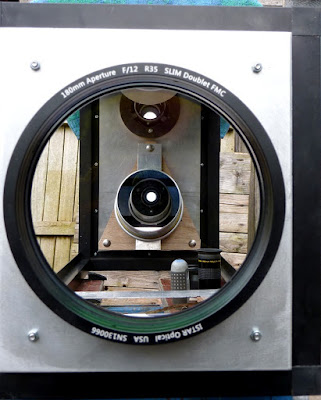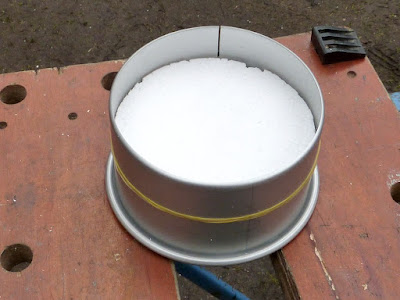*
 I intended to leave the cell retaining shells full depth at 75mm. So I needed to make up the 35mm distance between the back of the 5" mirror blank to the 12mm, plywood backing disk. The plan was to use dowels glued into matching holes in the backing disk. Then I noticed I had some 35mm polystyrene sheet and quickly cut out a packing circle to fit the shell. My intention is to ventilate the shells eventually to allow the mirrors to cool more rapidly in falling temperatures. This will require that the shells are largely empty.
I intended to leave the cell retaining shells full depth at 75mm. So I needed to make up the 35mm distance between the back of the 5" mirror blank to the 12mm, plywood backing disk. The plan was to use dowels glued into matching holes in the backing disk. Then I noticed I had some 35mm polystyrene sheet and quickly cut out a packing circle to fit the shell. My intention is to ventilate the shells eventually to allow the mirrors to cool more rapidly in falling temperatures. This will require that the shells are largely empty.
It is vital to be able to remove the folding mirrors from their shell without having to touch the reflective, front surfaces. Fortunately I had already split the shell to make room for the slightly over-sized blank. So there was never any danger of the larger mirror blank becoming stuck.
I looked around the workshop for a suitable band, pipe, strap or heavy rubber band but nothing popped up. So I chose to use black gaffer tape to hold the assembly temporarily together. The adhesion of the tape is high but not impossible to peel it off if needed. The narrow retaining rim on the shell is hard to see but it is there.
Here is the polystyrene disk in place. The rubber bands are just to keep things snug. I placed the 5" mirror on top of the polystyrene which was already resting on the backing disk. Then I carefully lifted the sandwich up into the vertical shell. Now I could apply the tape using a full wrap and the tape gap opposite the cut.The tape and polystyrene are only temporary to give me a stable test set-up. If I had to cut the shells down in height any cell construction would have been wasted.
Here is the 1st folding mirror in its shell ready for more tests of the focus point. A single coach bolt projects from the backing disk to fix the cell assembly firmly to the tilt strip. The vital, backing disk, self tapping, fixing screws are not shown in this image.
 An even more distant tree now came to focus with 6mm, 1/4" extension of the focuser and the 2" star diagonal in place housing a 26mm Plossl. So I still need about 50mm or 2" more inward focus for focusing at infinity.
An even more distant tree now came to focus with 6mm, 1/4" extension of the focuser and the 2" star diagonal in place housing a 26mm Plossl. So I still need about 50mm or 2" more inward focus for focusing at infinity.
The 1st mirror is already using its maximum allowable diameter. So only the 2nd mirror can be used to adjust the position of the focal plane. The 2nd mirror will need to be pushed forwards by about 1" to move the focus 2" to the center of the focuser range. Or so I hope. I have not made a tilt strip for the 2nd mirror yet so I will have to allow for more forward extension in my design.
Now back to work on the 2nd mirror support. I still need to ease the backing disk diameter so it does not jam tight in the 4" mirror shell.
I made up a crude and deliberately thin support strip for the 2nd mirror. It was important that it was capable of being twisted into position, tilted etc. It proved to be ideal for achieving quick collimation without actually having to build anything out of thick plate. Though it vibrated like mad when I touched the telescope even while the OTA rested on the B&D workbench.
This time I was able to find some even more trees at 475 yards measured on Google Earth. The focus point was now at 55mm of the 80mm total movement on the Vixen focuser with the 2" star diagonal and 26mm Meade 4000 Plossl. Which is ideal since there will be plenty of reserve, inward focuser movement for astronomical objects at infinity.
A collimation plate on springs will ensure there is already some forward projection before the 2nd mirror is fixed to it. I shall need to measure the precise position of the 2nd mirror relative to the framework so I can replicate its position when properly mounted.
I made up a crude and deliberately thin support strip for the 2nd mirror. It was important that it was capable of being twisted into position, tilted etc. It proved to be ideal for achieving quick collimation without actually having to build anything out of thick plate. Though it vibrated like mad when I touched the telescope even while the OTA rested on the B&D workbench.
This time I was able to find some even more trees at 475 yards measured on Google Earth. The focus point was now at 55mm of the 80mm total movement on the Vixen focuser with the 2" star diagonal and 26mm Meade 4000 Plossl. Which is ideal since there will be plenty of reserve, inward focuser movement for astronomical objects at infinity.
A collimation plate on springs will ensure there is already some forward projection before the 2nd mirror is fixed to it. I shall need to measure the precise position of the 2nd mirror relative to the framework so I can replicate its position when properly mounted.
 This is a quick shot taken through the 180mm, 7" objective of the folding mirrors and bright eyepiece spot pointing straight up at the sky. This was with the 2" star diagonal in place.
This is a quick shot taken through the 180mm, 7" objective of the folding mirrors and bright eyepiece spot pointing straight up at the sky. This was with the 2" star diagonal in place.The mirrors look quite small in this shot but completely different when looking down into the empty star diagonal. From there the mirrors almost fill the field of view. Pulling back from the objective rapidly increases the apparent size of the mirrors but I found it impossible to focus on the objective as well. The camera wanted to photograph the mirrors and ignored the objective cell.
My next task is to build a collimation plate to go inside the Porsa framework shoulder. A slotted, stronger tilt bracket will ensure mirror stability during carriage to and from storage. And also while fitting the OTA to the mounting and during observing at all altitudes.
Looking down on the 2" Vixen focuser, 2" dielectric star diagonal and Meade 4000 32mm Plossl.
The focus point has worked out perfectly with the two precision mirrors in place. I have two different focuser adapters thanks to owning one refractor and one reflector type, Vixen 2" focuser. The longer adapter brought the focus nearer to the middle of the focuser's range of movement.
It is odd how the field of view changes with the angle of the folding mirrors. Each time I adjusted the 2nd mirror the trees would rise or fall right out of the field of view.
Having a slot in the tilt strip is ideal for adjusting the height of the 1st mirror relative to the framework. I will have to do the same with the 2nd mirror mounting. Physical height in the OTA framework is not the same thing as tilt.
An image of trees at 475 yards taken through the 32mm Plossl plus 2" star diagonal, using a Canon Ixus 117HS short zoom camera. It was very difficult to center the image in the viewfinder screen without causing the 2nd mirror to shake like a leaf on its springy, temporary bracket. I have brightened the image slightly as it was a heavily overcast day.
The visual view at 67.5x in the 32mm eyepiece was much brighter and very much sharper. I was watching some Jackdaws in the same tree and could easily have seen flies at this distance if they had been present. The objective and optical folding mirrors are not even remotely collimated yet.
Click on any image for an enlargement.
*




2 comments:
Chris,
It's starting to look and feel like a telescope - great progress. As you've noticed, very small movement to the mirrors does have a large impact on the goodness of collimation and image position, so I think you will be glad of the larger tilt plates. The question of whether to shorten the overall front to back length and the cells can as you say remain open for now.
Just a thought, which others contemplating Porsa may find useful: do you have any feel yet for the overall stiffness of the framework if it were to be supported in the way ultimately you envisage? Some kind of mock-up of that may be useful before proceeding too much further, in case diagonal braces of any kind are needed (perish the thought..!)
Andrew
Hi Andrew
The focus point is/was predictable based on the position of the 2nd mirror. Any doubts I might have expressed were the result of the 2nd mirror position being poorly defined in both my lash-ups. Propping up the 2nd mirror with the shell was not accurate enough to be a reliable indicator. Now I have the mirror positions properly defined the focus point is exactly as I would wish it for objects 475 yards away. Fine tuning of OTA length might be possible after cutting down the mirror shell depths. I may become bored and decide to try that one day.
The Porsa framing system is remarkably rigid without additional bracing or applying a stressed skin. Porsa is routinely used for supporting heavy fish tanks. I am still looking for a lightweight sheet material to box in the framework. Covering the top of the OTA greatly helps contrast.
Chris
Post a Comment